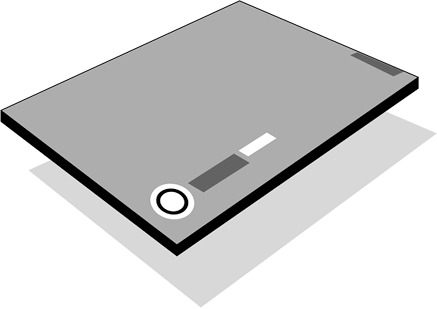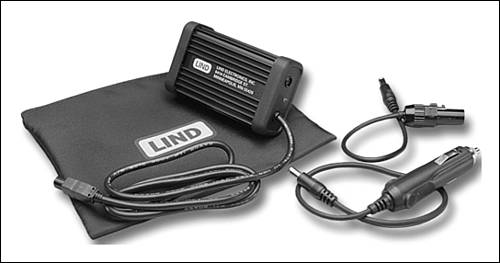Accessory Power Sources
| Notebook computers spend most of their working hours powered by an AC adapter. The great advantage of a notebook, however, is its ability to temporarily free itself from the AC power grid and work on battery power. BatteriesMost users have a number of options to choose from when it comes to laptop batteries. The most common one is the notebook's primary battery. These come in many different sizes and shapes and are specific only for a certain model of notebook. It is usually a good idea to buy a second, replacement battery for your notebook. This will enable you to double your laptop's effective battery endurance for those situations where it is required. Also, consider that if you own your notebook for more than a year or two, you will probably have to buy a replacement battery anyway. Notebook batteries last only for a given number of charge cycles. Over time, their endurance times will gradually decrease until they become unusable. Modular Device Bay BatteriesTo avoid the inconvenience of shuffling numerous batteries in and out of your notebook, some notebook models also offer an auxiliary battery that fits into the system's modular device bay. This enables you to run your notebook on two batteries simultaneously and to charge both of them easily. On most notebooks that offer this option, the total battery endurance time will be doubled . Note, however, that using such a battery cuts down on your storage options. To insert a module bay battery, you will probably have to remove your notebook's optical drive (either CD-ROM or DVD). Extended Life BatteriesA handful of notebooks have available optional extended-life batteries. These batteries are designed to replace the original battery and provide extra power. Usually they are available only on small ultralight notebooks. Unfortunately, in addition to increasing the battery endurance, they also substantially increase the size and weight of a notebook. A good example of an extended-life battery is the IBM ThinkPad T40 Series high-capacity Li-ion battery, which provides up to one-third more capacity than the standard battery for the T40. This battery fits in the standard ThinkPad T40 system battery slot yet has an extended area on the back edge of the notebook. Despite its larger size, it does not prevent the notebook from docking with IBM's various docking stations designed for this notebook. Slab BatteriesNew battery technologies enable designers to adopt innovative shapes that fit together more harmoniously with a notebook. One of these shapes is the slab, which is designed to fit under a notebook. A small number of notebook manufacturers have offered optional slab batteries for their lighter laptops. The IBM ThinkPad X30 Series extended-life battery is an example of a slab battery. It is designed to attach to the bottom of the ThinkPad X30 notebook. When combined with the notebook's standard battery, the slab can provide up to 8 hours of power. This battery adds a pound to the weight of the system. Third-party BatteriesA small number of companies offer batteries for the most popular notebooks. In some cases, even large battery manufacturers such as Duracell and Energizer have begun offering replacement notebook batteries. For a short time in the 1990s, the large battery manufacturers attempted to promote a series of standard batteries for notebooks. With such a standard, users would be able to purchase replacement batteries at a local Radio Shack without having to contact the notebook manufacturer or a specialized Web site. Unfortunately, as has happened in so many other areas of laptop design, the effort to come up with standard designs for these components has failed. Nevertheless, because of the popularity of laptops, there's now a large group of Web sites that stock a wide array of replacement batteries, covering almost any notebook that ever existed. Although the effort to develop standard batteries failed, some companies have offered generic batteries that can attach to a wide range of notebooks. These batteries are usually external and offer high capacities . One of the more interesting generic batteries for notebooks is the Electrovaya PowerPad 160 (see Figure 14.10). This relatively thin battery slips under a notebook and has a maximum capacity of 160WH, more than twice that of a typical notebook battery. It weighs 2.4 pounds and has the dimensions 8.75x11.75x0.38 inches. Figure 14.10. Electrovaya PowerPad 160, a generic battery designed to slip under a notebook. Fuel CellsA promising alternative to battery power is the fuel cell . These power sources do not require recharging and can run indefinitely as long as fuel is available ”usually a type of alcohol. Such a power source is ideal for areas where electrical power is undependable or nonexistent. Perhaps the first available fuel cell for laptops will be the Medion Energy Docking Station (www.medion.com). This device uses fuel cells developed by a German company called SFC Smart Fuel Cell AG (www.smartfuelcell.de/en/). A single, exchangeable fuel cartridge containing methanol will enable the docking station to power notebooks with electricity about three times longer than a conventional battery. Once a cartridge is empty, it can be "hot-swapped" with another (that is, exchanged without any power interruption). The Japanese giants NEC and Toshiba have also indicated interest in fuel cell technology. NEC has demonstrated a working prototype notebook PC with an internal fuel cell. The company claims that the compact prototype fuel cell achieves the world's best output density, 40mW/cm 2 , and achieves an average output of 14W and a maximum output of 24W. NEC aims to release a notebook PC with a built-in fuel cell on the market by end of 2004. By mid-2005, the company hopes to offer a notebook PC equipped with an internal fuel cell with an effective battery life of 40 hours. Meanwhile, Toshiba has announced the world's first prototype of a small form factor direct methanol fuel cell (DMFC) for portable PCs. The new fuel cell has an average output of 12W and maximum output of 20W, and it can supply approximately 5 hours of operation with a single cartridge of fuel. Toshiba reports that methanol in a fuel cell delivers power most efficiently when it is mixed with water in a 3% “6% methanol concentration, a concentration that would require a fuel tank that is much too large for use with a notebook computer. The company has overcome this problem by developing a system that dilutes concentrated methanol with the water produced as a by-product of the power-generation process. This technology allows methanol to be stored at much higher concentrations than in the past, with fuel tanks less than one-tenth the previous size. Toshiba's prototype can operate for approximately 5 hours on 50cc of concentrated methanol. In addition, the company has designed its DMFC with the same electrodes as found on lithium-ion batteries, allowing it to connect easily with a laptop and serve as an alternative to lithium-ion batteries. Toshiba is aiming at commercializing this technology in 2004. AdaptersBecause even the largest battery only lasts for a relatively short amount of time, most users try to run their notebooks off other power sources whenever they can. A number of adapter cables are available to help these users. Automobile AdaptersThere are two ways to power your notebook while in a car. The most generic approach is to purchase an inverter. This plugs into the car's cigarette lighter and converts the car's 12V DC power into 120V AC power. The user can then simply plug the notebook's AC adapter into the inverter. Although this approach does not involve the purchase of any proprietary cables or connectors, it is not very efficient. Electrical power must be converted from DC to AC by the inverter and then back again to DC by the notebook's AC adapter. During both of these conversions, some of the electrical energy is used up and given off as heat. A more efficient approach is to use a proprietary automobile adapter. These adapters consist of a cable with two connectors. The first is a standard connector for the car's cigarette lighter. On the other end of the cable is the proprietary power plug that connects directly to the notebook, in effect replacing its AC power adapter. Airline AdaptersA number of years ago, a few airlines began equipping certain seats in first class and business class with DC power outlets. Most automobile adapters now include special connectors that allow these adapters to be used on airlines as well. One source for airline power adapters is Lind Electronics (http://lindelectronics.com). That company's adapters all operate from an automobile's cigarette lighter. With the addition of a small converter cable, however, they can also connect to the power ports on some airlines (see Figure 14.11). Figure 14.11. A notebook power adapter from Lind Electronics for cars and airlines. The small converter cable at the right enables the adapter to work with the power ports on some airlines. InternationalAnyone who travels outside the western hemisphere will probably want to bring along an international power adapter. Depending on how many countries you will visit, you may need to bring along several adapters. Fortunately, most notebook AC adapters are capable of handling both 120V and 220V power. Therefore, all that most notebook users need is a relatively small adapter that converts the familiar two- or three-prong U.S.-style plug into one that will fit international power outlets. These adapters are usually sold in a batch of adapters that will handle most countries of the world. |
EAN: 2147483647
Pages: 182

